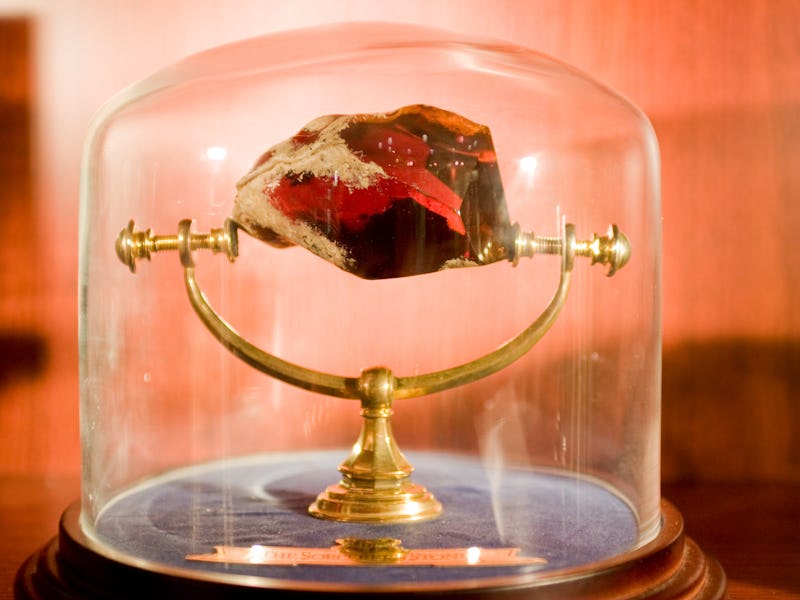Following Isaac Newton's Recipe for the Philosopher's Stone Cost $199.23
Alchemy is surprisingly affordable -- cheaper than gold anyway.

Let’s get this out of the way: No waxy red stone will ever catalyze the transformation of lead into gold. The so-called Philosopher’s Stone, the dream of every alchemist, will never be a reality because lead and gold are different atomic elements and that’s not how things work. Still, the attempts to discover the Stone, notably the attempts by Sir Isaac Newton to do so, remain fascinating. It’s no small wonder that Newton’s recipe for alchemy, posted by the Chemical Heritage Society, is making the rounds online.
The Chemical Heritage Foundation recently came into possession of a 17th century alchemy manuscript handwritten by Isaac Newton. To be totally clear, the manuscript does not contain Newton’s recipe for a Philosopher’s Stone, just his transcription of an experiment created by American chemist George Starkey, who went by the incredible wizard pseudonym of Eirenaeus Philalethes. The manuscript is titled “Praeparatio mercurij ad lapidem per regulu” — Latin for the “Preparation of mercury to a stone through metallic antinomy and silver.”
The “‘sophick” stone described in the manuscript stands for “philosophic” mercury, which Starkey hypothesized could be manipulated to make a stone with the ability to turn base metals into precious ones. And, yes, let’s cut to the chase: You can try to make the stone yourself with some choice Amazon purchases.
If you want to look legit, but not actually get anything done, get this $460 LARP-approved alchemy set. But you would be better off setting up a basic chemistry equipment kit, which goes for $48. Find a flammable-proof space to work and get cooking.
You can get mercury for $120 and you can get a bag of sulfur for $12.25 plus free shipping. Starkey’s instructions mention combining the fired up mercury and sulfur with some silver — which you can also get on the internet, in capsule form for $18.98. Break those babies apart and throw them in.
Great, you’ve got your raw materials. Now, follow these simple steps:
“Marry [sulfur] with, that is our [mercury] which is impregnated with must be espoused with our gold then hast thou two sulphurs married & two s of one of[f]spring whose father is the [gold] & [silver] the mother.”
Simple, right?
Essentially, Starkey’s instructions are a process of heating sulfur, mercury, and silver over and over again — an effort to break down metals in order to create a new one. It’s unknown whether Newton actually ever did this experiment — he didn’t write about this in any of his laboratory notebooks — but James Voelkel of the Chemistry Heritage Foundation says that it “would not have been out of character” for him to give it a go.
The Chemistry Heritage Foundation bought the manuscript after it was auctioned through Bonhams after being kept in a private collection. It’s thought to be from about 1670 — essentially a “just between us bros” early edition of the 1678 version that would be printed for mass consumption. The contents of this manuscript have never been seen by the public before now, and experts hope to get more eyes on the documents. Indiana University academics are planning on transcribing the manuscript and uploading the images as part of their “The Chymistry of Isaac Newton” project.
Originally a stack of Newton’s manuscripts were labeled “not fit to be printed” after his death, but that didn’t stop a sale of these papers by his descendants in 1936. The insistence on not revealing the papers to the public likely came from two concerns: The fact that some of these experiments simply did not work out and the popular ridiculing of alchemists at the time. Alchemy was actually illegal in England from 1404 to 1689, more because the kings didn’t want their subjects making their own gold, but also because the dawn of the Enlightenment meant a new crew of guys who scoffed at the “science” of alchemy. These Enlightenment thinkers spread rumors that alchemists were just necromancers concerned with sorcery. Meanwhile, Newton was a very serious and prominent scientist who figured out the universal laws of motion and gravitational attraction. The fact that he also wanted to make a stone that would give him unlimited gold is inconsequential to his legacy.
Newton dedicated 30 years of his life trying to make alchemy work to little success — at least not in the ways he was hoping. But while alchemists never truly figured out how to turn one element into another, they were able to invent new alcohol, brightly colored paints, heavy-duty soap, and new drugs (many of which would be considered hazardous in 2016.)
And while alchemy has become a lost art, we actually can transfigure elements today. But it’s less boiling lead and more firing up commercial nuclear reactors and experimental fusion reactors — both methods used by physicists to transform one element into another. The Lawrence Berkeley National Laboratory was even able to create gold by using a particle accelerator to produce gold out of the metallic element bismuth. Sure, the amount of gold was so small that they could only identify it by measuring its radiation over the course of a year — but that little bit of gold is still a hell of a lot more real than the philosopher’s stone.